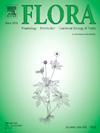在单株植物中,被虫食损害的叶片与未受损害的叶片具有不同的生物力学特性
IF 1.8
4区 生物学
Q3 ECOLOGY
引用次数: 0
摘要
昆虫食叶是一种广泛存在的生态系统现象,对植物的生长、生存、群落结构和生物多样性的维持具有重要影响。以往的研究主要集中在昆虫食草性的种间和种内差异及其与叶片性状的相关性上,但对叶片对昆虫食草性敏感性的个体内差异研究较少。以中国西南亚热带森林40种木本树种584株幼苗5583片叶片为研究对象,对叶片大小、比叶面积、含水量、厚度和韧性等5个关键性状进行了研究。我们的研究结果表明,同一株植物的这些性状在虫害和未虫害叶片之间存在显著差异,虫害叶片更大、更厚、更硬,但SLA和含水量较低。这些模式在不同物种间是一致的,表明一种保守的机制影响着抗虫食草性性状的进化。此外,我们的发现为未来的草食研究提供了有价值的见解,特别是在实验设计方面。单纯依赖完整叶片的性状可能会降低叶片性状对草食影响的可靠性。为了保证草食研究的稳健性,还应考虑受损叶片的性状。本文章由计算机程序翻译,如有差异,请以英文原文为准。
Leaves damaged by insect herbivory have consistently different biomechanical traits compared to undamaged leaves within individual plants
Leaf herbivory by insects is a widespread phenomenon across ecosystems, significantly impacting plant growth, survival, and community structure and biodiversity maintenance. While past research has mainly focused on interspecific and intraspecific differences in insect herbivory and its correlation with leaf traits, intra-individual variation in the susceptibility of leaves to insect herbivory remains under-investigated. Here, we investigated 5583 leaves from 584 seedlings of 40 woody species from a subtropical forest in southwestern China, focusing on five key leaf traits: size, specific leaf area (SLA), water content, thickness, and toughness. Our results revealed significant differences in these trait properties between insect-damaged and undamaged leaves from the same individual plant, with damaged leaves being larger, thicker, and harder, but having lower SLA and water content. These patterns were consistent across species, suggesting a conserved mechanism influencing the evolution of traits resisting insect herbivory. Furthermore, our findings offer valuable insights for future research on herbivory, particularly in terms of experimental design. Relying solely on traits from intact leaves may compromise the reliability of the leaf trait effects on herbivory. Traits of damaged leaves should also be considered to ensure the robustness of herbivory research.
求助全文
通过发布文献求助,成功后即可免费获取论文全文。
去求助
来源期刊

Flora
生物-植物科学
CiteScore
3.30
自引率
10.50%
发文量
130
审稿时长
54 days
期刊介绍:
FLORA publishes original contributions and review articles on plant structure (morphology and anatomy), plant distribution (incl. phylogeography) and plant functional ecology (ecophysiology, population ecology and population genetics, organismic interactions, community ecology, ecosystem ecology). Manuscripts (both original and review articles) on a single topic can be compiled in Special Issues, for which suggestions are welcome.
FLORA, the scientific botanical journal with the longest uninterrupted publication sequence (since 1818), considers manuscripts in the above areas which appeal a broad scientific and international readership. Manuscripts focused on floristics and vegetation science will only be considered if they exceed the pure descriptive approach and have relevance for interpreting plant morphology, distribution or ecology. Manuscripts whose content is restricted to purely systematic and nomenclature matters, to geobotanical aspects of only local interest, to pure applications in agri-, horti- or silviculture and pharmacology, and experimental studies dealing exclusively with investigations at the cellular and subcellular level will not be accepted. Manuscripts dealing with comparative and evolutionary aspects of morphology, anatomy and development are welcome.
 求助内容:
求助内容: 应助结果提醒方式:
应助结果提醒方式:


